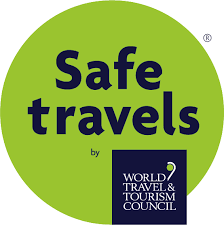The World Travel & Tourism Council last year introduced the “Safe Travels” stamp to assist travelers in recognizing those entities which have adopted the core protocol requirements of the WTTC. We at Securely Travel think it is an excellent initiative, which provides travelers with an easy way to know if the service being used is thinking about the traveler’s safety
Traveling in the age of COVID is challenging be it domestic or international. Knowing that the airline, hotel, ferry, car rental or other entity is paying attention to basic requirements in maintaining a sanitary and safe(r) environment is of import to us all.
So what are the WTTC Safe Travels protocol requirements? We went to their site and pulled these from the guidance they provide to those applying for their Safe Travels stamp. Armed with this information, you the traveler know what the expectations behind the stamp are and if the entity is not measuring up, point them to the disconnect between what the Safe Travels stamp implies and the reality before you.

The protocols SHOULD:
- Unless critical, provide recommendations/guidance rather than requirements.
- Evolve protocols according to level of risk at the destination.
- Have realistic health, sanitation, disinfection, distancing, and safety protocols that businesses of all sizes can, and can
afford to, implement. - Aim to reduce physical contact between staff and guests through the implementation of contactless/touchless
solutions where possible. - Recommend rather than require the use of certain technologies, such as contactless payments or digital menus.
- Promote online bookings over in-person reservations where applicable
- Provide personal protective equipment (PPE) for their employees, and make available PPE for guests, if not free, at a
cost. - Recommend that travellers wear a mask when interacting with people, in all modes of transports, during excursion
and when in indoor venues - Urge travellers to maintain physical distancing to the best of their ability and wash and sanitise their hands often and
thoroughly - Consider making available hand-sanitiser, beyond high-traffic areas for sale rather than providing it to all guests to
alleviate pressure on businesses. - Where possible, ensure employees apply proper hand hygiene rather than enforce the use of gloves which may
impede their tasks - If travellers present COVID-19 symptoms, respond proactively and with a solution that will ensure the mental and
physical wellbeing of the traveller/guest - Develop simple rather than complex and costly solutions to protect staff and guests and ensure business continuity.
For example, installing plexiglass can be recommended, but should not be imposed due to potential cost / space
issues. - Have thoughtfully considered sustainability and eco-friendly solutions within the recommended measures, including
avoiding single-use as much as possible and instead recommending appropriate cleaning/hygiene measures. - Refer to physical distancing rather than social distancing.
- Recommend that businesses request that their suppliers and partners follow likeminded protocols.
- In the case of aviation, comply with the International Civil Aviation Organization’s “Takeoff: Guidance for Air Travel
through the COVID-19 Public Health Crisis”
The protocols SHOULD NOT:
- Add friction to the traveler/guest experience unless absolutely necessary.
- Enforce capacity limitations, unless absolutely necessary (and never in the case of families with children), which make
it financially unsustainable to run operations. This is typically anything below a 70% capacity. - Require demarcation of physical distancing limits unless specifically for queuing purposes.
- Enforce physical distancing limits above 1.5m, unless absolutely necessary
 Travel Securely Securely Travel
Travel Securely Securely Travel